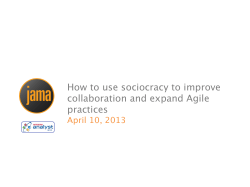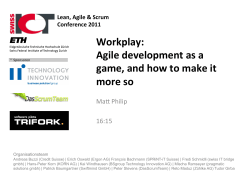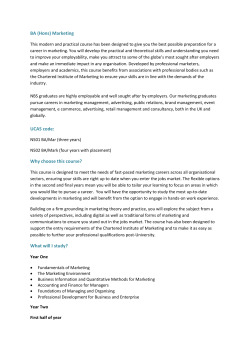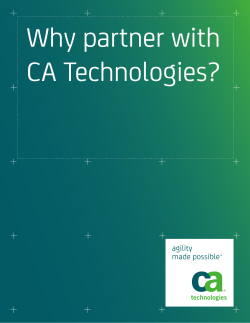
Improving Supply Chain Management in Public Health and Social Care
Improving Supply Chain Management in Public Health and Social Care Services with an Agile BPM Approach Jukka Korpela 1, Kalle Elfvengren 1, Tanja Kaarna 2, Merja Tepponen 2, Markku Tuominen 1 1 Faculty of Technology Management Lappeenranta University of Technology Skinnarilankatu 34, FI-53850 Lappeenranta, Finland jukka.korpela@roce.com, kalle.elfvengren@lut.fi, markku.tuominen@lut.fi 2 South Karelia District of Social and Health Services, P.O. Box 24, 53101 Lappeenranta, Finland tanja.kaarna@eksote.fi, merja.tepponen@eksote.fi Abstract This paper presents a case study of implementing new supply chain processes and solutions for patient placement in the South Karelia District of Social and Health Services (Eksote). Eksote is a forerunner in health and social care services development in Finland as it combines primary and secondary health care, elderly care and social care in a totally new way covering eight municipalities that were earlier working independently. The paper describes how an agile Business Process Management (BPM) approach was utilized for developing new operating models and supporting process solutions for the short term and long term patient placement processes. The focus of the short term placement process is to relocate patients from the central hospital to bed wards at the general practices while the long term placement process aims to place elderly persons to suitable wards or retirement homes. The BPM approach is based on agile development where end user involvement is essential in order to capture the true needs and requirements of the users. The paper describes the empirical experiences received both about the BPM-based development process and about the actual usage of the solutions in daily operations. On an annual level, thousands of patients are placed by using the developed solutions which have proved to improve both the efficiency and the effectiveness of the supply chain operations significantly. Keywords: supply chain management, SCM, public health care, agile BPM, Business Process Management 1. Introduction The public health care and social services sector in Finland is facing increased pressure to maintain or even improve the service level while decreasing operating costs. Effective supply chain management processes and supporting IT systems have a major impact on both the service level and the operating costs, and thus focus must be put on these areas in public health and social care organizations. In South Karelia in South-Eastern Finland previously separate municipal health care and social services (see Figure 1, stage 1) were integrated into a new organization called Eksote in the beginning of 2010 (Figure 1, stage 2). Health and social services are now closely integrated together in the South Karelia Region. Eksote combines primary and secondary health care, care of the elderly and social care in a totally new way. Since then Eksote has arranged services for its 8 member municipalities with approximately 130 000 inhabitants. Eksote employs approximately 4 100 people and has a budget of 380 million euros. The goal of Eksote is to increase the productivity of work by developing the processes without decreasing the quality of care. Eksote aims to define a new process model based on “a clean slate” so that the old municipal or organizational borders do not affect the planning process. The professionals at Eksote are currently working together to create new client oriented and cost-effective service processes that span over different professional areas. The functionality of the developed processes is based on jointly agreed operation models and trust between professions. At this stage the service structure and electronic patient records have been integrated in the area of South Karelia. Eksote aims at developing the integrated service structure further into the next stage (Figure 1, stage 3), where the connections and ties between different actors within the organization are clear and functional. Additionally, the goal of Eksote is to create a partnership network and to strengthen flexible and client-oriented cooperation with different actors, such as Kela - the Social Insurance Institution of Finland, the Employment and Economic Development Office, the third sector, the private sector, and other municipal actors. Integrated service processes are more functional, cost effective and client-oriented. Figure 1. Eksote service structure development (SHC = Secondary health care, Mol = the Employment and Economic Development Office, Kela = the Social Insurance Institution of Finland) The traditional way of thinking, stemming from units and municipalities has to be replaced with comprehensive client and process -oriented thinking in order to ensure that the strategy of Eksote will succeed. The new organization has to create commonly agreed operating models which can steer all actors towards the common goal. In the traditional model, all social and health care actors functioned in different organizations, and furthermore, the services were arranged by ten different municipalities separately (Figure 1, stage 1). Figuratively speaking, Eksote aims to turn the territories into resources. One of the most essential functional goals is to reduce the use of institutional care radically. The client’s whole care process has to be seen as one whole continuum which begins from home and continues fluently back to home again (Figure 2). This requires seamless cooperation in the network of 2 actors. Implementing the strategy requires turning the strategic goals into distinct practical actions. Finding sufficient time for working on strategic goals and new common operating models was found challenging in the new organization. Those in charge were well aware of the development needs of the process in their own specialty areas. The development needs were often connected to the interfaces between the previously separated organizational units. Figure 2. Client-oriented service process 2. Agile Business Process Management Business processes are a fundamental component of any organization. A business process is an activity or set of activities that will accomplish a specific organizational goal. Effective setup, execution and development of business processes are essential to successful business operations. Business process management (BPM) is a systematic approach to making an organization's workflow more effective, more efficient and more capable of adapting to an ever-changing environment. BPM is an approach to facilitating business processes that involves organizations, people and technologies, and which can be executed with varying levels of automation. The goal of BPM is to reduce human error and miscommunication and focus stakeholders on the requirements of their roles. The trend is toward more flexible ways of working, shorter organizational reaction times and fully embracing market and business unpredictability, along with the increase in distribution and the need to preserve understandability despite more and more complexity (Rimassa and Burmeister 2007). Business processes have often been classified into two categories. The first concerns welldefined and often repetitive processes and they have also automation and coordination needs. The second category concerns loosely structured processes which can be called knowledgeintensive. The essential preoccupation with the latter is the knowledge and information sharing between the actors implied in the processes. Business processes of this category require more flexibility. (Nurcan 1996; Nurcan 1998). 3 The traditional BPM systems are using formal process models which are used to govern the execution of business processes. These systems act as a centralized control hub, and invoke functions in ERP systems and business applications based on a formal plan given by the process model. (Schatten and Schiefer 2007) Agile BPM provides automated and managed structures to provide repeatable business processes, while at the same time, provides the ability to act immediately, in real time to circumstances that are unforeseen in those processes. Agile BPM moves processes out of a pre-defined and predictable processes box into handling difficult cases that elude traditional formalized process management techniques. According to Schatten and Schiefer (2007) the principles of agile BPM are: (1) empowering individuals by emphasizing flexibility and responsiveness over efficiency and predictability (2) responding quickly and intelligently to events in the business environment (3) give highest priority to sense and respond to customer needs, and preferences in order to continuously deliver value to the customer. Agile process management is not a technological challenge but a challenge in establishing suitable company policies and culture. Employees have to be encouraged to try out new ways. (Schatten and Schiefer 2007) Serena Business Manager (SBM) is a business process management platform developed by Serena (www.serena.com), a US-based software development company. SBM is being widely used by companies and it has proven to enable quick and cost-effective implementation of business processes. Serena has summarized the advantages of SBM (Serena.com). The most important advantages are the following: • • • • With SBM, processes are designed with an intuitive drag-and-drop tool. After defining the roles for the actors in the process, the designed process can be taken into use immediately as SBM automatically generates a live, web-browser –based application. Thus, application development is very quick and allows for an iterative approach in refining the process. SBM uses web services for seamless integration to the existing IT infrastructure. SBM has extensive reporting features which enable process managers to analyze process lead times and identify process bottlenecks. Every action by the persons involved in a process is recorded with a time-stamp which gives total transparency to the efficiency of the process. Processes usually change and evolve over time, and SBM enables changes to be done and implemented quickly. SBM has extensive change management capabilities allowing process managers to track and manage process versions. The author´s practical experience about process development with SBM has shown that the SBM is applicable especially to human-centric processes. The implementation time has ranged from a few days to two months depending on the complexity of the process. The Serena software was utilized Eksote’s supply chain process development. 3. Eksote supply chain network Eksote is working to address the challenges brought by the increasing number of elderly people and people potentially in need of care. The number of elderly people (aged over 75 years) in South Karelia will double in the next thirty years from approximately 10 000 in year 2010 to over 20 000 in year 2040. Eksote’s Elderly Care Services provides preventive care, home care, home nursing, day activities and support services. Elderly Care Services arranges also sheltered housing, housing at the nursing homes and care at the health center hospital bed 4 wards. There are various regional health centers with bed wards across the area and one central hospital in Lappeenranta (Figure 3). Eksote has about 700 acute and long term hospital beds and approximately 1000 beds in different sheltered housing services and nursing homes. The integrated organization creates excellent possibilities for developing social and health care services for a larger area as a single entity. Financial transactions between municipalities regarding patient placement decisions are not needed and this is one of the reasons why a centralized placement, Assess–Qualify–Place (AQP), model can be efficiently utilized by Eksote. Instead of making the placement decisions locally, Eksote turned the problem into an area-wide logistical question, how to fill available bed places at GPs with patients that have the most urgent needs. Eksote formed a centralized AQP office that handles all the patient placement decisions in the area. Figure 3. South Karelia district of social and health care services Eksote’s AQP office has handled all the patient placement decisions in the area since November 2010. The AQP office uses Eksote`s common Electronic Patient Health Record and Electronic Social Service Client system. The AQP office is responsible for both shortterm and long-term placements. The short-term placement process focuses on organizing further care for patients that don´t need special health care in a hospital anymore. The longterm placement process focuses on organizing long-term care for elderly persons in retirement homes, assisted living homes or long-term wards in hospitals either in publicly or privately owned facilities. The AQP office consists of multiple specialized discharge and placement nurses and social workers who focus solely on patient placement. These AQP nurses assess the patients’ needs and make the placement decisions instead of doctors and nurses in the wards. Different parties have clear responsibilities and therefore the use of the professionals’ time is more productive. 5 The queues shorten and customer needs can be taken into account better as the patients are getting the needed treatment as quickly as possible. The benefits of this exceed the downside of sometimes possibly having to be placed some 100 kilometers from home. 4. The challenges in the short-term AQP -process The limited amount of beds especially in the special health care wards caused a growing need to pay attention to discharging patients home or to send them to receive further treatment to GP bed wards as early as possible. The problem was that doctors and nurses lacked the understanding of bed resource availability in the area. This resulted to a great amount of inefficient point-to-point communication for finding a suitable further treatment ward for the patients and too much time spent on non-care related activities. The original short-term AQP -process was also too heavy and unstructured. There were no clear rules or screening on who could be submitted to assessment. This caused lack of process control and discipline. Information exchange happened through phone calls and e-mails and proved to be time-consuming and stressful for each party. At first, patient placements were handled by using an Excel-spreadsheet but it was not adequate. It lacked up-to-date availability information of beds in GPs, overall control and auditability of the process were at an unsatisfactory level, there were no clear ownerships and roles in the process, process metrics were missing, and the data content was not properly structured. The overall comparison between the original way of working and the targeted way of working is presented in Figure 4. Figure 4. Comparison between the original and targeted way of working (Roce Partners, 2011) 6 5. New process design and supporting computer solution In order to improve the efficiency of the short-term AQP -process (Figure 5), Eksote made the decision to utilize an agile BPM approach to develop a new computer-based solution for the process. Based on earlier experiments, Serena Business Manager was selected as the platform to build the new solution on. Eksote decided to utilize an external partner, ROCE Partners (www.roce.com), to support in process and solution development. Figure 5. Short-term placement process (Roce Partners, 2011) The essential actor in the development project was the core project team that consisted of about ten representatives of the special health care wards, the AQP office and the GP bed wards. One external consultant was working intensively with the core project group. The project consisted of the following main phases: • Process definition: The most important phase of the project was the process definition. The objective of this phase was to analyze the current short-term AQP -process, to define the needed improvement areas and to agree on the new, improved process design (Figure 6). The new process design formed the basis for the new computerbased solution. The process definition phase lasted about two weeks and consisted of interviews of multiple stakeholders in addition to the core project team workshops. • Solution development: Once the new process design had been agreed on, the external consultant created the initial version of the computer-based solution with the Serena Business Manager (SBM) within a couple of days. The initial version was used as the basis for the iterative development process with the core project team. The core project team had frequent meetings where they went through the existing version of the solution and defined the needed changes, adjustments and additions. Based on the core team feedback, the external consultant created a new version of the solution for the core project team to review. This iterative approach to solution development proved to be very efficient as the core project team was able to see a live system, to give their comments and to see the impact of their feedback in the solution almost instantly. The iterative solution development process lasts about three weeks. • User acceptance testing and training: When the core project team was satisfied with the features of the developed solution for the short-term AQP -process, the solution was put into user acceptance testing. The objective was to test the usability of the solution with a wider user group and to identify potential errors. As the core project team had been able to work very closely with the solution for three weeks, the developed solution proved to be quite well-working and no major errors or lacking features were identified. 7 • User training and implementation: The user base for the short-term AQP -process consists of about 500 persons, and thus the user training could have been an extensive effort. However, the solution created with SBM proved to be so easy to use that a brief 2-hour introduction was basically enough for others but a few nominated key users. The user roles in SBM-based solutions are so strictly and clearly defined that the users can only see the functionalities they are allowed to access. Furthermore, the webbrowser –based user interface is very clear and intuitive and guides the user very effectively. An illustrative example of the user interface is shown in Figure 7. The user trainings took about two weeks in calendar time, and thus after eight weeks from the start of the project, the new solution for the short-term AQP -process was successfully implemented in the organization. Figure 6. The process design for the short-term AQP process 8 Figure 7. An illustrative example of the user interface (ROCE Partners, 2011) The agile BPM- and SBM-based approach to the short-term AQP -process development proved to be quick and cost-effective. Within a time span of 8 weeks, the new process design was defined and a new computer-based solution was created and implemented. The main success factor for the project was the iterative development approach which allowed the core project team to have a constant impact on the developed solution. The design of the process and the features of the solution were based on exact requirements and needs of the users, and the SBM platform proved to be flexible enough to accommodate all of the user needs into the solution. Another benefit of the iterative approach was that the core project team was not required to finalize a set of requirements and specifications for the solution in one step but their requirements were also allowed to evolve by seeing the various versions of the solution over time. The feedback by the core project team was very positive at the end of the project as they noted that for the first time they got a solution that exactly met their expectations and requirements. The utilization of the new solution started very smoothly in Eksote. Despite the big number of users, there were only minor technical or user-related issues to be resolved. The change management was handled efficiently and basically all users started using the solution from the day one. Thus, the benefits of the system started to be seen almost instantly: • The number of phone calls between the AQP office and the other actors in the shortterm AQP -process decreased dramatically. Information about the patients and available beds in GP wards was visible to all parties in real-time through the new solution, and thus phone calls were only needed in exceptional situations. The decreased number of phone calls released lots of working time for more effective use for all parties in the process. • The effectiveness and lead time of the short-term AQP -process improved drastically and the queues in the process practically disappeared. If there were queues, they were caused by the fact that there were no available beds for placement and not by the fact that the AQP office didn´t have time to process all patients in a timely manner. • The created solution helped in clarifying the roles of each party in the process. The computer-based solution didn´t allow any deviations from the intended role for any of the actors, and thus the process was implemented according to the agreed design. This is a major challenge in many organizations as defining a process is quite 9 • straightforward while the actual implementation of the process in the organization can be quite slow and difficult. The new solution gave transparency to the process and enabled measurability of the process. All actions in the process are recorded with a time stamp, and thus the duration of each process step and the overall process lead time can be measured. After couple of months, there was already enough data to help in identifying the bottlenecks in the process and to take corrective action. An illustrative example of process steps can be seen in Figure 8. Figure 8. An illustrative example of process steps (ROCE Partners, 2011) 6. Conclusions The agile BPM-based approach to the development of the new solution for the short-term AQP –process was applied successfully in the South Karelia District of Social and Health Services (Eksote). A new process design was defined and it was implemented by utilizing the Serena Business Manager (SBM) software platform to create a computer solution for the process. The development project was based on an iterative approach that enabled the users of the process and the solution to ensure that the final outcome matches their specifications and requirements exactly. The implementation of the new process and solution was executed smoothly and the benefits of the new way of working started to be seen immediately. The new solution decreased the time used on value-adding activities, improved the process lead time and enabled overall management of the process. The positive experiences and results from the short-term AQP process encouraged Eksote to apply the agile BPM and SBM approach to other processes as well. Since the first process implementation, new process designs and supporting SBM-based solutions have been created in areas like the long-term AQP –process, the AQP-process for mental health care patients, the AQP process in child welfare and even the diagnostics process of ADHD patients. Based on wider discussions within the public health care and social services organizations in Finland, 10 the agile BPM approach shows a lot of potential in improving the effectiveness of their operations. Furthermore, we can assume that this approach is applicable to all public health care and social services internationally. References Nurcan, S., 1996. A method for cooperative information systems analysis and design: CISAD. Proceedings of the Second International Conference on the Design of Cooperative Systems, Juan-Les-Pins, France, 12–14 June. Nurcan, S., 1998. Analysis and design of co-operative work processes: A framework. Information and Software Technology, 40(3), 143–156. Rimassa, G., Burmeister, B., 2007. Achieving business process agility in engineering change management with agent technology. Agenti e Industria: Applicazioni tecnologiche degli agenti software, Genova, Italy, 24-25 September. Roce Partners, 2011. AQP process presentation, internal report, www.roce.com. Serena.com, 2012. Top ten reasons to leverage SBM, internet document, http://www.serena.com/docs/repository/sbm/SBM-Solution-Sheet-November-2010.pdf. Schatten, A., Schiefer, J., 2007. Agile business process management with sense and respond. IEEE International Conference on e-Business Engineering, Hong Kong, China, 24-26 October. 11
© Copyright 2025













